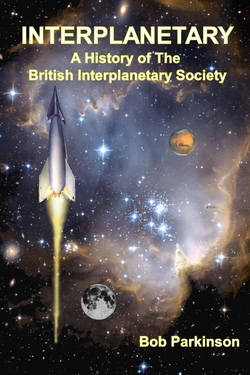Centauri Dreams
Imagining and Planning Interstellar Exploration
First Light for NEAR: Searching for Planets around Centauri A and B
I marvel that so many of the big questions that have preoccupied me during my life are starting to yield answers. Getting New Horizons to Pluto was certainly part of that process, as a mysterious world began to reveal its secrets. But we’re also moving on the Alpha Centauri question. We have a habitable zone planet around Proxima, and we’re closing on the orbital space around Centauri A and B, a G-class star like our Sun and a cooler K-class orange dwarf in a tight binary orbit, the nearest stars to our own.
At the heart of the research is an instrument called a thermal infrared coronagraph, built in collaboration between the European Southern Observatory and Breakthrough Watch, the privately funded attempt to find and characterize rocky planets around not just Alpha Centauri but other stars within a 20 light year radius of Earth. The coronagraph blocks out most of the stellar light while being optimized to capture the infrared frequencies emitted by an orbiting planet. Note that point: We are talking not about reflected starlight, but infrared emission as a potentially Earth-like planet absorbs energy from its star and emits it at these wavelengths.
The instrument is called NEAR (Near Earths in the AlphaCen Region), developed by teams working at the University of Uppsala (Sweden), the University of Liège (Belgium), the California Institute of Technology and Kampf Telescope Optics in Munich, Germany. Installed at ESO’s Very Large Telescope on one of the four 8-meter instruments there, NEAR upgrades the existing VISIR (VLT Imager and Spectrometer for the InfraRed) to improve contrast and sensitivity, aiming at one part in a million contrast at less than one arcsecond separation.
Remember how daunting a challenge Centauri A and B present. At their most distant, the two stars are about 35 AU apart as they orbit their common barycenter. Orbital eccentricity drops that figure to a mere 11 AU as they close during their 79.9 year orbit. Imagine our night sky if we, like a hypothetical planet around Centauri B, had a G-class star at roughly Saturn’s orbit.
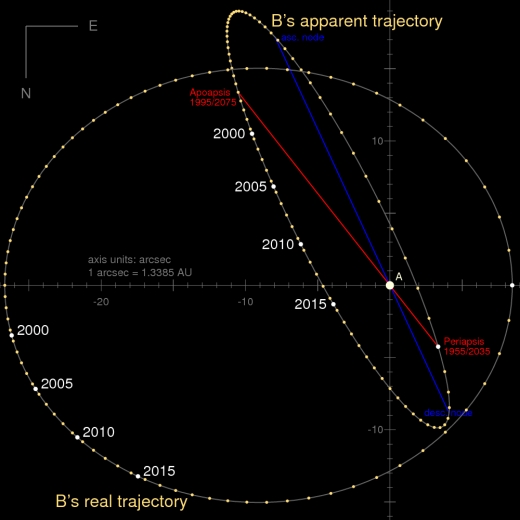
Image: Apparent and true orbits of Alpha Centauri. The A component is held stationary and the relative orbital motion of the B component is shown. The apparent orbit (thin ellipse) is the shape of the orbit as seen by an observer on Earth. The true orbit is the shape of the orbit viewed perpendicular to the plane of the orbital motion. According to the radial velocity vs. time [12] the radial separation of A and B along the line of sight had reached a maximum in 2007 with B being behind A. The orbit is divided here into 80 points, each step refers to a timestep of approx. 0.99888 years or 364.84 days. Credit: Wikimedia Commons.
Then, too, imagine what our view of the universe would be if we had evolved in a place where the night sky held planets around our own star as well as our tight companion, one of which was a habitable world. We have no idea whether such worlds exist around either of the primary Centauri stars, but NEAR has us on pace to learn something soon. My guess is that any civilization in such a setting would have a tremendous spur to develop spaceflight to explore a potential second home that would be within reach of the kind of technologies we have today.
The coronagraph that the NEAR effort brings to VISIR is what should make it possible to detect the signatures of terrestrial-class worlds, just as adaptive optics can screen out atmospheric effects that would distort the vanishingly faint signal (Markus Kasper at the ESO likens this task to detecting a firefly sitting on a lighthouse lamp from several hundred kilometers). NEAR’s ability to reduce noise and switch rapidly between target stars on a 100 millisecond cycle means that in all such operations, precious telescope time is maximized.
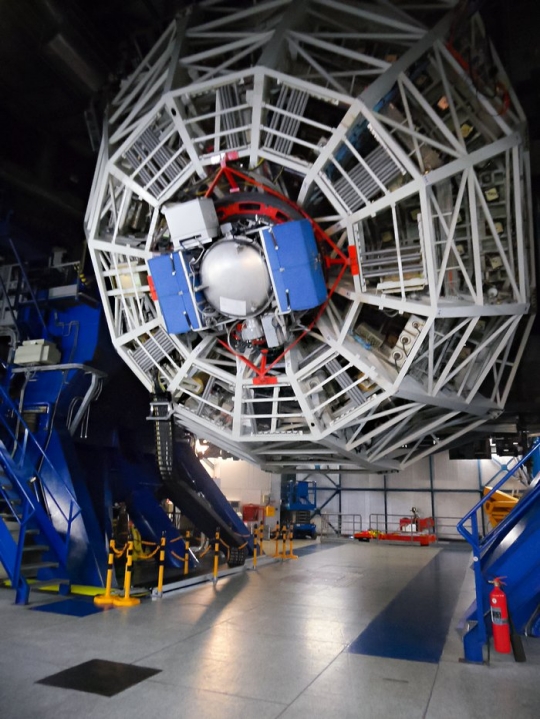
Image: ESO’s Very Large Telescope (VLT) has recently received an upgraded addition to its suite of advanced instruments. On 21 May 2019 the newly modified instrument VISIR (VLT Imager and Spectrometer for mid-Infrared) made its first observations since being modified to aid in the search for potentially habitable planets in the Alpha Centauri system, the closest star system to Earth. This image shows NEAR mounted on UT4, with the telescope inclined at low altitude. Credit: ESO/ NEAR Collaboration/.
So where are we now? A ten-day observing run on Alpha Centauri has been conducted since May 23, with observations concluding today. According to the ESO, planets twice the size of Earth or larger should be detectable with the upgraded VISIR. Consider too that working at near- to thermal-infrared wavelengths will allow astronomers to make a call on the temperature of any planet detected with these methods, an obvious clue to potential habitability.
“NEAR is the first and (currently) only project that could directly image a habitable exoplanet. It marks an important milestone. Fingers crossed – we are hoping a large habitable planet is orbiting Alpha Cen A or B,” says Olivier Guyon, lead scientist for Breakthrough Watch.
Data from the NEAR work will be made publicly available from the ESO archive, with a ‘pre-processed and condensed package’ of all the data offered shortly after the campaign ends. This ESO news release notes that a high-contrast imaging data reduction tool called PynPoint has been adapted to process NEAR data. Those without their own data reduction tools can learn more about the software’s installation and setup for NEAR at this PynPoint page.

LightSail 2 Inspires Thoughts on Fictional Sails
Solar sails are a case of science fiction anticipating the scientific journals, though in an odd way. Engineer Carl Wiley (writing as Russell Saunders) described the physics of solar sailing and some early engineering concepts in the pages of John Campbell’s Astounding back in 1951, but he did it in a nonfiction article of the kind the magazine routinely ran. Richard Garwin would discuss sails in the scientific literature in “Solar Sailing: A Practical Method of Propulsion within the Solar System,” which ran in 1958 in the journal Jet Propulsion.
Then we waited for fictional treatments, which began with Cordwainer Smith’s wonderful “The Lady Who Sailed the Soul” (Galaxy, April 1960) and a string of stories from top authors of the time in just a few quick years — Jack Vance’s “Gateway to Strangeness” (Amazing Stories, 1962), Poul Anderson’s “Sunjammer” (Analog 1964), Arthur C. Clarke’s story of the same name, later renamed “The Wind from the Sun” (Boy’s Life, 1964). Sails of the solar kind had definitely arrived.
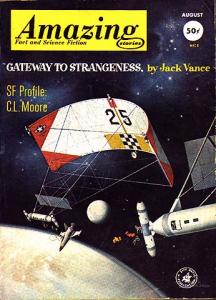
Because he is a personal favorite, let me run a clip from the Jack Vance story, which later became known as “Sail 25” (available in various places, but most easily in the 1976 collection The Best of Jack Vance). This is what solar sailing looked like in the days when the nautical metaphor was just beginning to be explored, and a fictional crew is learning, with the help of space veteran Henry Belt, to handle the unusual demands of sail deployment.
“Around the hull swung the gleaming hoop, and now the carrier brought up the sail, a great roll of darkly shining stuff. When unfolded and unrolled, and unfolded many times more it became a tough gleaming film, flimsy as gold leaf. Unfolded to its fullest extent it was a shimmering disk, already rippling and bulging to the light of the sun. The cadets fitted the film to the hoop, stretched it taut as a drum-head, cemented it in place. Now the sail must carefully be held edge on to the sun, or it would quickly move away, under a thrust of about a hundred pounds.
“From the rim braided-iron threads were led to a ring at the back of the parabolic reflector, dwarfing this as the reflector dwarfed the hull, and now the sail was ready to move.
“The carrier brought up a final cargo: water, food, spare parts, a new magazine for the microfilm viewer, mail. Then Henry Belt said, ‘Make sail.'”
It sounded complicated in 1962, but in the era of the IKAROS sail, we’ve learned how tricky actual deployment is, and also how incredibly thin high-performance sails will need to be, particularly as we look toward future missions with cutting-edge materials. Geoff Landis, for example, has examined sails of niobium, beryllium and transparent films of dielectric (non-conducting) materials like silicon carbide, zirconia and diamond-like carbon — a material much like diamond — that could be assembled in space with a plastic substrate.
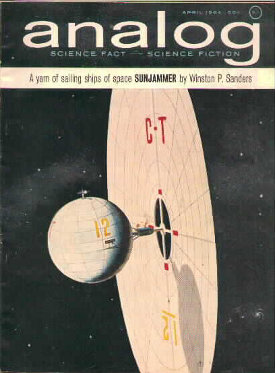
James Davis Nicoll recently wrote up some examples of sails in science fiction that include the early ones mentioned above, but also more recent work like the novels in Vonda McIntyre’s ‘Starfarers’ sequence and the 1974 tale “The Mountains of Sunset, the Mountains of Dawn.” Also catching Nicoll’s attention is Joan D. Vinge’s “View from a Height,” which should interest anyone exploring the human motivations for immense journeys, and Alastair Reynolds’ Revenger (2016). I hope readers will supply some of their own favorites in science fictional sails. Laser sails play a prominent role in Larry Niven and Jerry Pournelle’s The Mote in God’s Eye (1974), for example, the ‘mote’ being evidence of a sail heading in our direction. And then there’s Forward’s Rocheworld… The list is extensive!
Image: Poul Anderson’s “Sunjammer” appeared in April, 1964, about a month after Arthur C. Clarke’s story of that name, and to make matters even more confusing, ran under the pseudonym ‘Winston P. Sanders.’ Both stories were milestones in early sail depictions.
Like Nicoll, I’m looking back at sail technologies partly because we’re coming up on the launch of The Planetary Society’s LightSail 2, which is now scheduled for no earlier than June 24 aboard a SpaceX Falcon Heavy. The CubeSat spacecraft about the size of a loaf of bread and weighing 5 kilograms will deploy a small sail and attempt to raise its orbit by the momentum imparted by solar photons. I’m a great partisan of CubeSats, particularly those with sail capabilities, for fleets of the inexpensive spacecraft, further miniaturized, networked and tapping solar radiation, can become a great way to deploy sensors all through the inner system.
LightSail is no 5,000-mile behemoth, like the staggering sail of Cordwainer Smith’s story — its four booms will unfurl four triangular panels with a combined area of 32 square meters, and as The Planetary Society’s Jason Davis tells us, the craft will receive a push ‘no stronger than the weight of a paperclip.’ But continual thrust is just the ticket as the effects mount up, and LightSail 2 will be in an orbit high enough (720 kilometers) that the effects of atmospheric drag can be overcome. Expect LightSail 2 to be deployed from the Prox-1 spacecraft that encloses it about seven days after launch. All good wishes on the attempt!
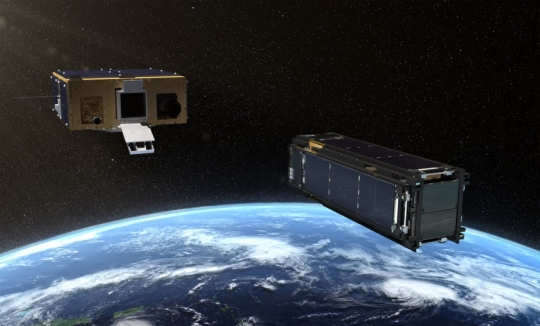
Image: Prox-1 deploys the LightSail 2 spacecraft in Earth orbit. Credit: The Planetary Society (CC BY-NC 3.0).

Exoplanet Moons in Formation?
We’ve been looking at circumstellar disks for quite some time, and teasing out images of actual planets within them, as witness HR 8799, where four exoplanets have been found. Just recently we saw imagery of a second world around PDS 70, both planets seen by direct imaging as they plowed through the disk of dust and gas surrounding a young star. All told, we now have more than a dozen exoplanets that have been directly imaged, though only two are in multi-planet systems. PDS 70b is sweeping out an observable gap in the disk.
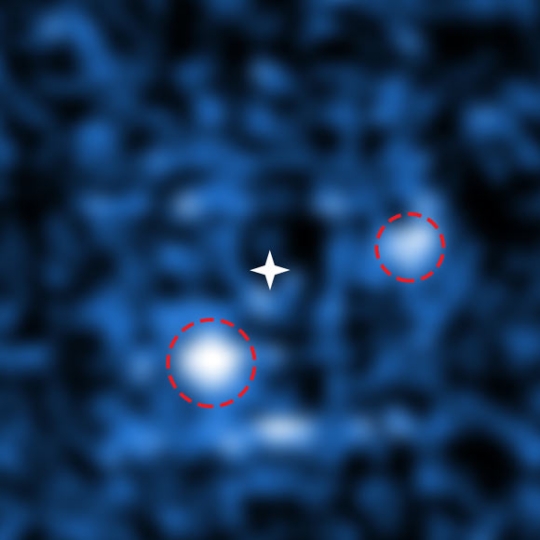
Image: PDS 70 is only the second multi-planet system to be directly imaged. Through a combination of adaptive optics and data processing, astronomers were able to cancel out the light from the central star (marked by a white star) to reveal two orbiting exoplanets. PDS 70 b (lower left) weighs 4 to 17 times as much as Jupiter while PDS 70 c (upper right) weighs 1 to 10 times as much as Jupiter. Credit: ESO and S. Haffert (Leiden Observatory).
Now we learn that within the same system, we have evidence for the first circumplanetary disk, forming around PDS 70b, the innermost of the two worlds. The planet is about 3.2 billion kilometers from the host star, in an orbit roughly similar to that of Uranus in our own system, and was discovered last year before recent work revealed the existence of PDS 70c. The study, led by Monash University (Australia) and including an international team, worked with an algorithm developed to extract faint signals from Very Large Telescope data.
Led by Valentin Christiaens at Monash, the team worked at infrared wavelengths to analyze the spectrum of the planet produced by SINFONI (Spectrograph for INtegral Field Observations in the Near Infrared) at the VLT, analyzing three hypotheses to explain what they saw. The best fit to the data was a model that incorporated a developing atmosphere as well as a circumplanetary disk, for atmospheric models alone could not account for the observed flux.
Here’s the image that appears in the paper on this work:
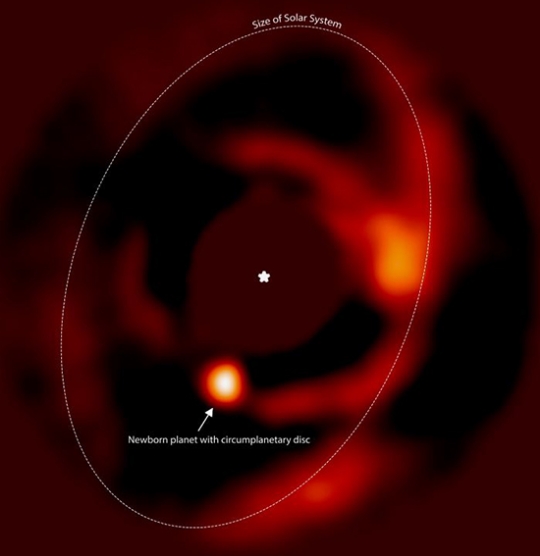
Image: Infrared image of the newborn planet PDS 70 b and its hypothesized circumplanetary disc, within its birth environment. Size of the Solar System given for comparison. Credit: V. Christiaens et al./ ESO.
This is a tentative finding, as the authors acknowledge. They list several caveats, including their use of a limited range of atmospheric models and a data fit that is not perfect. The paper also discusses the possibility that the assumptions between their circumplanetary disk models may be incorrect. But supporting the circumplanetary disk result is the fact that the team’s calculated accretion rates for the planet agree with observation, while the presence of specific carbon monoxide emission features supports a forming accretion disk around the planet.
And there is this:
Presence of a spiral arm. Our conclusion regarding the presence of circumplanetary material around PDS 70 b is consistent with recent images obtained with VLT/SINFONI, suggesting the presence of an outer spiral arm likely feeding the CPD [circumplanetary disk].
If follow-up observations can firm up the hypothesis, we would be seeing a newborn giant planet forming its own family of satellites, much as many scientists believe Jupiter did as it evolved in the circumstellar disk. There is also the interesting 2:1 resonance in the two planetary orbits, so that the inner planet orbits twice for every single revolution of the outer world. What bearing this may have on theories of giant planet migration in our own system may become clearer as we examine more young exoplanets that display the same kind of resonance.
If we do have a satellite-forming disk around a planet here, we can add that to the mix as we try to firm up our models of giant planet formation. “Despite an intensive search circumplanetary discs have until now eluded detection,” says Christiaens. “This first piece of evidence suggests theoretical models of giant planet formation are not far off.”
The paper is Christiaens et al., “Evidence for a Circumplanetary Disk around Protoplanet PDS 70 b,” Astrophysical Journal Letters Vol. 877, No. 2 (3 June 2019). Abstract / Preprint. The discovery of the second young planet around PDS 70 is discussed in Haffert et al., “Two accreting protoplanets around the young star PDS 70,” Nature Astronomy 3 June 2019 (abstract).

1999 KW4: Close-Up of a Double Asteroid
I’ve argued in these pages that the interstellar effort will be driven as much by planetary protection as by the human exploratory impulse. I count the latter as crucial, but we often think of planetary protection as an immediate response to a specific problem. Let’s place it, though, in context. Now that we’re actively cataloging asteroids that come near the Earth, we have to know how and when to react if what looks like a dangerous trajectory turns into a deadly one. That mandates a continued level of observation and progress on mitigation technologies.
A small nudge counts for a lot with an object that’s a long way out, and we can’t exclude, for example, long period comets in our thinking about planetary protection. So mitigation strategies that begin with changing the trajectory of a small, nearby object will grow with our capabilities to encompass more distant options, and that incentivizes the building of a defensive infrastructure that can operate deep into the Solar System. We need deep space technologies that can not only form a warning network but a defensive screen in case a threat develops.
We’ll build out a Solar System infrastructure one day that can do these things, one with inevitable consequences for the technologies that also foster exploration far beyond Sol. So when I see the recent images of the asteroid 1999 KW4, I’m also reminded of another binary asteroid called Didymos. With its companion (‘Didymoon’), Didymos is to be the subject of a NASA asteroid mitigation experiment, in which the DART spacecraft will impact the small moon in 2022 to gauge orbital changes that can be induced around the larger object. The European Space Agency will follow up with data from the asteroid in 2026 in a mission called Hera.
As to DART itself, the acronym stands for Double Asteroid Redirection Test. We’re talking about an impactor demonstrating the kinetic effects on the tiny object to see just how effective a deflection strategy may be. Didymos is not an Earth-crosser but it does provide a useful venue for the experiment. It’s worth remembering that a variety of options exist for asteroid mitigation, but DART will offer the first kinetic impact test at a scale realistic for planetary defense.
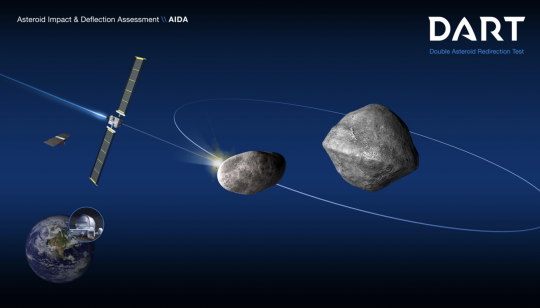
Image: Schematic of the DART mission shows the impact on the moonlet of asteroid (65803) Didymos. Post-impact observations from Earth-based optical telescopes and planetary radar would, in turn, measure the change in the moonlet’s orbit about the parent body. Credit: NASA/Johns Hopkins Applied Physics Lab.
But back to 1999 KW4. which was imaged by the SPHERE instrument (Spectro-Polarimetric High-Contrast Exoplanet Research) on the European Southern Observatory’s Very Large Telescope. SPHERE was designed to be an exoplanet hunter using adaptive optics to screen out atmospheric distortion, but it proved its mettle much closer to home by providing sharp images of an asteroid just 1.3 kilometers wide that flew by the Earth in late May, offering the opportunity for an observing campaign coordinated by the International Asteroid Warning Network (IAWN).
“These data, combined with all those that are obtained on other telescopes through the IAWN campaign, will be essential for evaluating effective deflection strategies in the event that an asteroid was found to be on a collision course with Earth,” said ESO astronomer Olivier Hainaut. “In the worst possible case, this knowledge is also essential to predict how an asteroid could interact with the atmosphere and Earth’s surface, allowing us to mitigate damage in the event of a collision.”
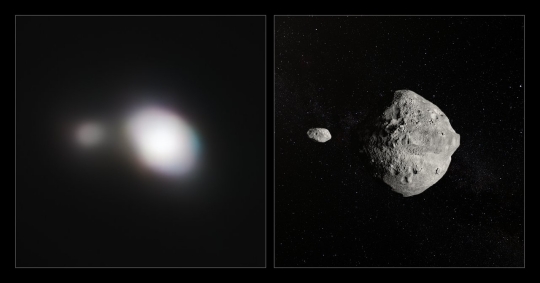
Image: The unique capabilities of the SPHERE instrument on ESO’s Very Large Telescope have enabled it to obtain the sharpest images of a double asteroid as it flew by Earth on 25 May. While this double asteroid was not itself a threatening object, scientists used the opportunity to rehearse the response to a hazardous Near-Earth Object (NEO), proving that ESO’s front-line technology could be critical in planetary defence. The left-hand image shows SPHERE observations of Asteroid 1999 KW4. The angular resolution in this image is equivalent to picking out a single building in New York — from Paris. An artist’s impression of the asteroid pair is shown on the right. Credit: ESO.
The two components of 1999 KW4, separated by about 2.6 kilometers, were moving at approximately 19.5 kilometers per second as they flew past the Earth, a challenge for observers not only because of their faintness and fast motion, but because atmospheric conditions were unstable at the time and the SPHERE adaptive optics system crashed more than once, though operations were quickly restored. The asteroid and tiny satellite reached a minimum distance of 5.2 million kilometers from Earth on May 25, about 14 times the distance to the Moon.

An Atomic Clock for Deep Space
NASA’s Orbital Test Bed satellite is scheduled for launch via a SpaceX Falcon Heavy on June 22, with live streaming here. Although two dozen satellites from various institutions will be aboard the launch vehicle, the NASA OTB satellite itself houses multiple payloads on a single platform, including a modular solar array and a programmable satellite receiver. The component that’s caught my eye, though, is the Deep Space Atomic Clock, a technology demonstrator that points to better navigation in deep space without reliance on Earth-based atomic clocks.
Consider current methods of navigation. An accurate reading on a spacecraft’s position depends on a measurement of the time it takes for a transmission to flow between a ground station and the vehicle. Collect enough time measurements, converting them to distance, and the spacecraft’s trajectory is established. We know how to do atomic clocks well — consider the US Naval Observatory’s use of clocks reliant on the oscillation of atoms in its cesium and hydrogen maser clocks. Atomic clocks at Deep Space Network ground stations make possible navigational readings on spacecraft at the expense of bulk and communications lag.
While GPS and other Global Navigation Satellite Systems (GNSS) use onboard atomic clocks, the technologies currently in play are too heavy for operations on spacecraft designed for exploration far from Earth. That puts the burden on communications, as distant spacecraft process a signal from an atomic clock on the ground. What the spacecraft lacks is autonomy.
A better methodology is something we have to develop as we look toward a future deep space infrastructure. Testing the miniaturization of atomic clocks and methods to harden them for operations elsewhere in the Solar System is the goal of the DSAC demonstrator mission, which points to a clock architecture that is considerably more efficient and also scalable.
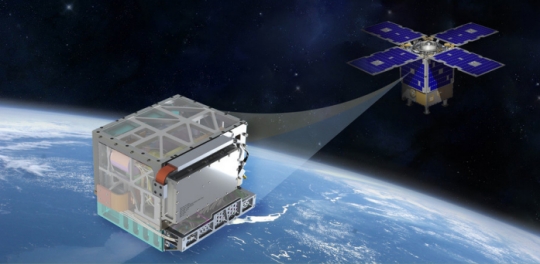
Image: JPL’s Deep Space Atomic Clock will fly aboard the General Atomics Electromagnetic Systems Orbital Test Bed satellite as a hosted payload and launched in June as part of the U.S. Air Force’s Space Technology Program 2. Credit: NASA.
The Deep Space Atomic Clock will be the first atomic clock designed to fly aboard a spacecraft going beyond Earth orbit and, with a stability of better than one microsecond in a decade, it is also the most precise clock ever flown. Ground-based testing has shown that the DSAC is up to 50 times more stable than the atomic clocks on GPS satellites, losing only one second in nine million years. NASA considers it an enabling device for future on-board radio navigation.
It is the length of a second as measured by the frequency of light released by specific atoms that makes an atomic clock so precise as it records the vibrations induced in a quartz crystal. Key to the DSAC clock’s stability is the use of mercury ion trap technology. Contained within electromagnetic traps within the device, these ions are rendered less vulnerable to external forces like changing magnetic fields and variations in temperature than atoms currently in use.

Image: DSAC mercury ion trap housing with electric field trapping rods seen in the cutouts. This is where DSAC interrogates and measures the mercury ion resonance that is used to discipline a quartz crystal clock. Credit: NASA.
The distances involved in deep space operations force new technologies upon us, for communicating with atomic clocks on Earth to determine a spacecraft’s location not only takes time but also places an increased burden on our communication resources, another reason why we’re moving toward networking multiple spacecraft in orbital operations at places like Mars.
The plan is to test DSAC in Earth orbit for one year, with the goal of adapting it for future missions to deep space. Developed at the Jet Propulsion Laboratory, the device has been under development for 20 years, reducing the size of atomic clocks from those used at Deep Space Network ground stations — about the size of a refrigerator — to an object the size of a four-slice toaster, and one that can be further miniaturized depending on the needs of future missions.
You can see that we’re gradually upping the navigation service volume, considering that spacecraft near Earth don’t require an integrated atomic clock, being able to use existing global navigation services like GPS. These technologies, using multiple GNSS constellations, can get us out as far as geosynchronous orbit, and DSAC promises accurate navigation deep into the Solar System. Ahead lies X-ray navigation that keys off the oscillations of remote pulsars, a galactic positioning system that points to missions moving, one day, far beyond our Sun.

A Supernova Link to Ancient Wildfires?
Did huge fires several million years ago force a transition from forest to savanna in northeast Africa? It’s a tantalizing thought, as such fires have been seen as a possible factor in driving the emergence of bipedalism in our remote ancestors. Adrian Melott (University of Kansas), who looks at the question in a new paper in the Journal of Geology, notes that our precursors would have adapted to such massive changes to their habitat, evolving to support life amidst the abundant grasslands that had replaced their former tree-filled environments.
The conjecture about early hominins is receiving a lot of attention, but it plays only a small role in this paper, which focuses on the linkage between supernovae activity and the period in question. Just how do we make the call on a nearby supernova? Melott has been studying the question for some time, and refers back to 2016 studies of ancient seabed deposits of iron-60 isotopes that appeared in Nature. At that time, two supernovae events, one from 1.7 to 3.2 million years ago, the other from 6.5 to 8.7 million years ago, were identified via iron-60 deposits.
The new study points to the accumulating evidence for supernovae in the vicinity of the Earth, finding the strongest signal at 2.6 million years, and notes that this may represent a series of supernovae beginning as far back as 7 million years that Melott relates to the clearing out of the Local Bubble, which is a cavity in the interstellar medium in the Orion Arm in which our own Local Interstellar Cloud is located. Supernovae are thought to have emptied this cavity.
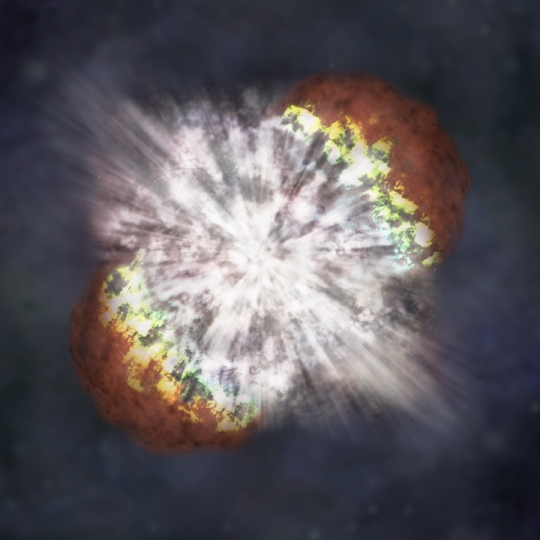
Image: Supernovae bombarded Earth with cosmic energy starting as many as 8 million years ago, with a peak some 2.6 million years ago, initiating an avalanche of electrons in the lower atmosphere and setting off a chain of events that conceivably ended with bipedal hominins such as homo habilis. Credit: NASA.
In the paper, Melott and colleague Brian Thomas (Washburn University) assume a supernova occurring 2.6 million years ago at a distance of 50 parsecs, or 163 light years, a time after the Local Bubble had already formed. The authors compute the extent of cosmic ray propagation and consider effects on terrestrial life, with particular regard to muons, the highly penetrating elementary particles that are the primary component of cosmic ray irradiation at the surface.
A key result is increased ionization of the atmosphere as a result of supernovae cosmic rays, with ‘electron avalanches’ set off that are the primary initiator of lightning (a still controversial idea, though one the authors cite recent evidence to support). From the paper:
A 50 times increase in atmospheric ionization in the troposphere would clearly make the breakdown and electron cascade much easier, and one could expect a great increase in lightning (e.g. Erlykin and Wolfendale, 2010). Furthermore, the originally isotropic distribution of cosmic rays would result in showers which are much more preferentially vertical, due to the variation in atmospheric column density with angle. So, not only would lightning be enhanced, but cloud-to-ground lightning should be preferentially enhanced. The theory of lightning initiation is not well-developed, and we cannot say that a 50-fold increase in ionization would lead to a 50-fold increase in the number of lightning events. However, the potential is there for a large increase.
As the paper notes, lightning is the main initiator of wildfires (excluding humans), and an increase in lightning strikes would be expected to induce large numbers of wildfires. The conversion of forest to savanna, a worldwide phenomenon beginning about 7 million years ago, may have been caused by the increase in wildfires associated with this period, as found in soot and other carbon-related sediments. Thus the notion, not emphasized in the paper, that supernovae could have played a role in human evolution. Here’s Melott on the matter:
“The observation is that there’s a lot more charcoal and soot in the world starting a few million years ago. It’s all over the place, and nobody has any explanation for why it would have happened all over the world in different climate zones. This could be an explanation. That increase in fires is thought to have stimulated the transition from woodland to savanna in a lot of places — where you had forests, now you had mostly open grassland with shrubby things here and there. That’s thought to be related to human evolution in northeast Africa. Specifically, in the Great Rift Valley where you get all these hominin fossils.”
Supernovae are not frozen in time, so the logical question is whether events like these could occur in our future. A possible future Type II supernova (resulting from the collapse of a massive star and subsequent explosion) can be found in Betelgeuse, which may light up the skies sometime in the next million years, according to current estimates. But at 200 parsecs, it is not likely to cause major consequences. Melott and Thomas see solar events as far more concerning as we consider solar flares in the context of our technological civilization.
The paper is Melott and Thomas, “From cosmic explosions to terrestrial fires?” published online by the Journal of Geology 28 May 2019. Abstract / Preprint.

